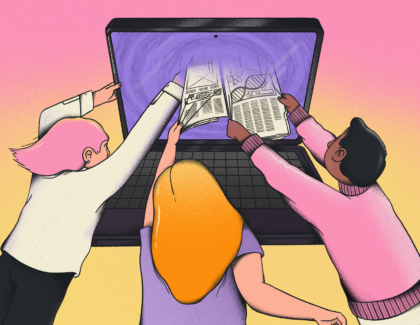Sign up for the daily CJR newsletter.
At the turn of the century, John Cusack came home to Chicago to shoot a movie called High Fidelity. In it, he played a sad-sack hipster hiding out from adulthood in his used record shop, Championship Vinyl. Toward the end of the film, a young woman walks into the store and introduces herself as Caroline Fortis, a music reviewer for the Chicago Reader, the city’s alternative weekly. “You’re Caroline Fortis?” Cusack says, incredulously. “I read your column. It’s great. You really know what you’re talking about.” He’s so smitten, he makes her a mix tape.
Vinyl records. Mix tapes. Alternative weeklies. They seem part of another era now. But in 2000, when High Fidelity came out, the Reader was still a totem of Chicago’s underground scene. Every Thursday, stacks of fat, four-section papers were piled in the lobbies of bookstores, coffee shops, nightclubs, and liquor stores. By that evening, the Reader was under the arm of every L rider on the way home from an office job in the Loop, and in the backpack of every thrift-store chick on a one-speed bike.
The paper was the source for music listings and apartment classifieds. Starting on the cover, and winding through the ads, was a long, reported-to-the-pencil-nub tale about curing multiple sclerosis with bee venom or corruption in the Tollway Authority.
Today, if you made a movie about Chicago hipsters, Caroline Fortis probably wouldn’t write for the Reader. She’d write for Time Out Chicago, or Pitchfork, the music Webzine. The Reader still hits the streets every week, but as a single-section tabloid. Last year, shortly after its purchase by Creative Loafing, the Tampa-based chain, the paper laid off its entire design staff and four investigative reporters. And there’s a feeling around Chicago that the Reader has failed to catch on with the younger generation, and perhaps failed to try, at least until recently.
In 1995, when I quit my job at a downstate Illinois newspaper and moved to Chicago, my goal was to work for the Reader. I broke in with a long narrative about learning to play the horses from a professional tout, and worked my way up to staff writer. It was the best job I’ll ever have. At the Reader, you could write about anything, at any length, in any style. I turned out pieces on a teenaged Frank Sinatra impersonator, a man who sold socks by the freeway, and the “callers” who drummed up business outside hip-hop boutiques on the South Side. When I wrote my first book, Horseplayers: Life at the Track, the Reader paid my salary while I went to the races every day. All I had to do was write about the gamblers, a subculture the Reader loved.
The Reader was launched in 1971. At the time, the paper’s lakefront stronghold was populated by a mix of gays, artists, musicians, actors, and young professionals who were skeptical of the first Mayor Daley’s political machine. The so-called Lakefront Independents were key swing voters during Harold Washington’s 1983 campaign to become Chicago’s first black mayor. Right before the election, the Reader published an article aimed at reassuring white voters about Washington’s credentials. Widely copied and stuffed under apartment doors, it helped him squeak to victory. Throughout the council wars between white aldermen and Washington’s minority allies, the Reader remained in the mayor’s corner. Its star reporter, Gary Rivlin, went on to write Fire on the Prairie, the definitive book on that divisive era in Chicago.
As a newspaper that serves a narrow circulation area, the Reader doesn’t get to choose its audience. And the yuppies who’ve colonized the lakefront over the last twenty years don’t seem as interested in rage-against-the-machine muckraking. Lincoln Park, the heart of Reader Country, now has one of the few Republican ward offices in the city. The average home sells for $525,000. The new residents love the current Mayor Daley, who is considered less corrupt and racist than his father. They credit him with making the city safe for Barneys New York and Japanese restaurants with valet parking. The Reader still carries the banner of the Lakefront Independents, but that movement is down to one or two aldermen.
Throughout my time at the Reader, we railed against Chicago’s new gloss. Some of it was personal—we wrote for an alternative weekly; we didn’t have a lot of dough. Some of it was the journalist’s sympathy for poor people getting the shaft (Neal Pollack, who’s gone on to success as a satirist, once filed a nineteen-thousand-word epic about a landlord/tenant dispute). And some of it was the sense that Chicago’s changes were robbing us of both our audience and our subject matter. A lot of us wanted to be Nelson Algren. But in today’s Chicago, Algren would have trouble finding an affordable apartment, let alone finding the man with the golden arm—a junkie drummer who deals poker in the backs of taverns.
The Maxwell Street Market, where old bluesmen played alongside junk peddlers, was torn down to make way for a college expansion. We wrote a cover story. An artist who illustrated alt-country album covers closed her record store and moved to Delaware. We published a farewell. One day, we got this letter: “Why don’t you write about these places while they’re still open?” Pollack once proposed writing a book called The Disappearing City. But the city wasn’t disappearing, it was evolving, as all great cities do. “I spent my entire career at the Reader chronicling the death of that Chicago, those weird little storefronts and bomb-in-pocket anarchists,” Pollack told me. “Part of me regretted it, and part of it was a funeral rite. Now, a lot of the old audience of the Reader has either moved away or died.”
When a potential new audience was moving onto the Internet, the Reader declined to follow. The Chicago Tribune, the paper dinosaur the Reader had been born to challenge, beat us to the Net with an entertainment site called Metromix. In 2004, the Reader, which had once defined hipness, finally tried to get hip again. The editors insisted on shorter stories, added features on fashion, and hired a tattooed, twenty-seven-year-old stripper to write a late-night party column. They also came out with a new design that finally brought color to the front page. The Trib’s media critic hailed it as bringing the paper “into the late 1990s.” The establishment daily was tweaking the alternative weekly for being behind the times. On the day the new cover debuted, I handed out copies at an L stop in Lincoln Park. Gray-haired men and women rushed to grab copies. But no one under thirty would touch one.
That’s the problem with being hip for one generation: you’re dated for the next. There are publications—Ms. and Playboy, for example—that defined their eras, but are now stuck with lists of aging subscribers. The average Reader reader is around forty. Its main print competitors, Time Out Chicago and RedEye, the Tribune’s free commuter tabloid, have younger staffs and younger readers. Not surprisingly, the Reader\’s recently cashiered reporters think it should have continued down its classic path. “Being young and hip was part of the definition of the Reader, and I think the feeling was the Reader had to be reinvented to stay that way, and change its character,” says Harold Henderson, one of the laid-off writers. “The problem is, you gotta be who you are. You can pretend to be forty years younger than you are, but you’re going to be who you are. It would have been nice, the strategy of trying to be what the Reader had been, and it might have failed, but it would have been an honorable failure.”
I quit the Reader in the summer of 2005. Officially, I left to research another book. Secretly, I believed the alternative weekly was an obsolete concept. The Internet had launched so many outlets, with so many agendas, that the Reader could no longer claim to be Chicago’s underground option to the Trib and the Sun-Times. Steve Rhodes, who publishes the local media blog Beachwood Reporter, thinks the Reader became complacent because it was still raking in ad profits through the early 2000s—before Craigslist looted its classifieds, driving profits into the red.
When the Reader’s founding owners sold to Creative Loafing, they acknowledged their vintage with this statement: “We’ve had a great ride. Now we’re happily handing the keys to a new generation.” Creative Loafing’s CEO, Ben Eason, thinks he can recapture the eighteen-to-thirty-five crowd while hanging on to Boomers who’ve grown into middle age with the Reader. The Web site—which only in 2005 began offering all Reader content, but in difficult-to-read PDF files—now features blogs on music, sports, food, and movies. The new restaurant section combines the old Reader and the new Reader perfectly: a recent column on soul food examined African American foodways while identifying South Side restaurants where readers would feel comfortable. And Eason has commissioned focus groups—a Reader first.
When Creative Loafing Atlanta did the same, he explains, “we found that it was a values game. You have to reach into the values of the sixties. A twenty-year-old today is still educated, serious, and community-minded.” The spirit of the alternative weekly is viable, he believes. But the tradition of spending months on a story is “economically unsustainable.” A small staff can still produce good journalism, Eason says. Creative Loafing Atlanta won an Association of Alternative Newsweeklies Award for an exposé on the Black Mafia Family, a drug ring/hip-hop label.
Alison True, the Reader’s editor since 1994, says that “long-form and investigative journalism aren’t necessarily the same thing, but we continue to publish both. For years, we’ve been mixing shorter cover stories with the long ones everyone remembers, but all you ever hear about are the super long ones. They’re the exception, not the rule.” Fair enough, but the paper fired its best investigative reporters, and at least one of them rebuffed True’s offer to continue as a freelancer.
The paper also pays less for features than it did a decade ago, which makes it harder to publish quality reporting. The Reader’s in-depth pieces made it different from every other paper in the city. If there’s no longer a place for them, will there still be a place for the Reader? The paper was engineered for a particular moment in Chicago’s, and journalism’s, history. Its challenge now is to transcend that without losing its identity or alienating readers who loved it for what it was. Alternative weeklies are expected to be eternally youthful. The Reader is finding that a tough act to pull off as it approaches forty. In High Fidelity, John Cusack eventually had to face the fact that he wasn’t one of the kids anymore.
Has America ever needed a media defender more than now? Help us by joining CJR today.






